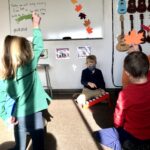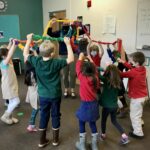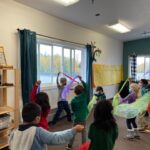I love fall. I love the colors, the smells, being able to still camp, and being colder but not too cold to have to pull out the heavy coat. Instead of shoveling snow, it is sweeping and raking leaves, rituals that mark time. I also love to teach with the seasons, doing this allows children to connect to the materials in a meaningful way and also allows for them to bring their perspective and ideas to the music lessons.
Apple Trees and Leaves Falling
Preschool students have been exploring songs through, singing, movement, instrument playing, stories and imaginative play, having to do with apple trees. I explained that I have a great big crab apple tree in my front yard and loved to hear if they have a crab apple tree or real apple tree at home. We climbed up the apple trees and practiced counting all the apples that have been shaken down. Mr. Play helped the preschoolers know when to play their shakers or not to play when we shook the apples down. Ask your kids who Mr. Play is. Gertrude and Mr. Play are my teaching tools that help children understand a myriad of concepts and behaviors. I have actually had my puppet Gertrude for over 20 years! We also played with leaves. The falling leaves lead us to explore high and low in music while the student’s hands moved like the leaves they had seen falling outside. The step bell was introduced to have them further explore high and low and create their own leaf songs.
Kindergarteners love to move! All children love to move and I believe that music and movement are taught together, as through the Orff process. So, we moved and sang of the falling leaves and explored being leaders playing the step bell of where the sound was going up or down. I saw what a musical group they are when they had their leaves move to Vivaldi’s Four Seasons ,Fall and begin to identify what they heard in the music. Ask your Kindergartners what the wiggle worm was. The wiggle worm helped the students learn to work together as a team and was a way to see where the high and low was in the music.
The first and second grader explored Autumn through movement as well with the help of scarves. Props, leaves and scarves, allow the student to be able to feel more comfortable moving, developing their musicality and it is just also fun! I am was amazed at how musical the students are at PNA! The students came up with words that might explain how they moved, twisted, turned, floated and explored how they would move to that with the music in small and large groups.
What are the sounds of fall? In the first-grade music room that involved our percussion instruments. First grade has been focusing on the un-pitched percussion instruments and the families that they belong to; Wood, Metal, Skin and Shaker/Scraper. We decided as a class what sounds work best on certain words in the Autumn Leaves song thus changing the songs from a lovely melody to something even more interesting and musical to hear and perform.
The second grade took a step further with exploring fall as they began to play Orff instruments, the metallophone and the xylophone. They were introduced to the correct playing technique and played the steady beat and a rhythmic pattern while the class sang. The students were learning the first steps to focus on their parts as one does in a choir, band and orchestra . After singing, playing and creating the second grade begin recognizing and identifying rhythms. The note recognition was related to language, using leaf names, and the students started reading and making their own rhythms with the use of leaf rhythm cards.
Ask your children to sing one of their leaf or apple songs or to show you a leaf rhythm. Better yet, grab a scarf or leaf or even a napkin and move to the recording I have added with your kids!
https://www.yourclassical.org/episode/2017/10/16/daily-download-antonio-vivaldi–autumn-i-allegro



